Unique Contact Designs Fit Niche Applications
Unique Contact Designs Fit Niche Applications
At the heart of every connector is a separable contact that establishes and maintains a low-resistance electrical interface that remains stable over the life of the product. More than making simple physical contact, it must:
- Plow through oxides and contamination on the mating surface
- Ensure adequate normal forces to resist vibration yet allow acceptable insertion/withdrawal forces without excessive wear
- Be fabricated from a copper alloy balanced between low bulk resistance and good spring characteristics
- Contain sufficient conductor cross-sectional area to support rated current
- Establish mechanically stable single or redundant points of contact to avoid fretting
- Utilize appropriate plating materials to match application performance and cost objectives
The pin-and-socket interface is probably one of the oldest and most reliable contact designs, and it remains the contact of choice in many connectors today. Pin and socket contacts can be found in diverse applications ranging from avionics equipment to consumer washing machines.
Over the years, many additional contact configurations with imaginative names such as Shepherds’ Crook, Box, Brush, Leaf, Cantilever Beam, and Tuning Fork have been developed. Each resulted from unique application requirements for performance, density, reliability, or cost.
In order to satisfy requirements for higher performance, many of these designs have continued an evolution to higher current rating, greater resistance to shock and vibration, and overall reliability. For instance, female pin-and-socket contacts are now fitted with internal bands that ensure redundant points of contact. Single leaf contacts can be bifurcated for the same reason. Contact base materials and plating are constantly being upgraded for improved manufacturability, environmental resistance, and current rating.
In spite of all of these attributes, and many years of proven performance, applications still arise that cannot be successfully served by connectors using traditional contacts. These needs are met by a separate realm of highly specialized interconnects designed to satisfy application-specific demands.
Hypertronics, now Smiths Connectors, introduced the first hyperboloid female contact to address low force redundant connectors in mission-critical applications that involve extreme shock and vibration. Amphenol Aerospace promotes the Bristle Brush contact, which consists of a series of tapered high-tensile wires that mesh together when mated to create a low mating force, in a highly reliable interface.
To a large degree, connectors designed for unique applications often utilize compression contact technology and feature advantages like signal density, high mating cycle life, ability to support exceptionally high pin counts, and long-term reliability. This makes sense, as the size of traditional pin-and-socket contacts can be reduced only so far before the limitations of stamp-and-form manufacturing kick in.
Exceptionally small pin-and-socket contacts can be fabricated using more exotic manufacturing processes, such as electroforming or chemical etching, but at a significant cost premium. Omron is an example of a connector supplier that has built their business around subminiature precision-manufactured connectors.
 Taking nano contacts one step further, Microfabrica utilizes a proprietary additive technology to build metallic structures with feature sizes down to 20 microns and dimensional tolerances of +/- 2 microns. Highly custom applications in the medical, aerospace, and defense industries can afford the cost that these precison contacts demand.
Taking nano contacts one step further, Microfabrica utilizes a proprietary additive technology to build metallic structures with feature sizes down to 20 microns and dimensional tolerances of +/- 2 microns. Highly custom applications in the medical, aerospace, and defense industries can afford the cost that these precison contacts demand.
By utilizing these advanced manufacturing techniques, the fabrication of spring contacts on a subminiature scale to achieve increased signal density and weight reduction can be facilitated, but this is typically not an appropriate solution for general market applications. An alternative to this approach is to utilize entirely different contact technology that takes advantage of compressive point contacts.
High-density, low-profile commercial connectors must be manufactured using high-volume manufacturing techniques in order to achieve price points acceptable to the markets they serve.
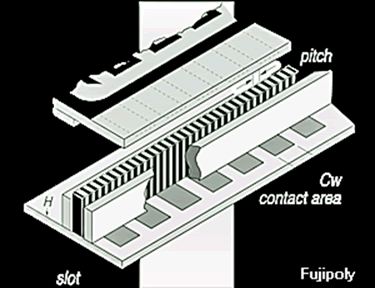 At the low end of the cost and performance spectrum are compressive contacts in the form of laminated conductive and elastomeric insulating layers. Conductive carbon layers on centerlines as small as 0.05mm provide redundant contact between parallel PCB pads. Although contact resistance is relatively high, ZEBRA-type connectors have been used for years in low-cost PCB-to-LCD display applications. For applications that require lower contact resistance and higher current rating, Fujipoly offers the Zebra Gold Series, which consists of parallel rows of gold-plated wires wrapped around a silicon rubber core.
At the low end of the cost and performance spectrum are compressive contacts in the form of laminated conductive and elastomeric insulating layers. Conductive carbon layers on centerlines as small as 0.05mm provide redundant contact between parallel PCB pads. Although contact resistance is relatively high, ZEBRA-type connectors have been used for years in low-cost PCB-to-LCD display applications. For applications that require lower contact resistance and higher current rating, Fujipoly offers the Zebra Gold Series, which consists of parallel rows of gold-plated wires wrapped around a silicon rubber core.
Another approach utilizes gold-plated traces on flex film wrapped around an elastomeric core.
Many unique contact designs have been created to address the challenge of applications in the semiconductor test and production socket market. This makes sense, as they typically require high pin counts on very small centerlines. Reliability is essential throughout the extended life of the equipment. Most utilize surface-mount or compressive attachment because the tiny centerlines preclude the use of thru-holes. A traditional pin-and-socket interface would create excessive insertion/withdrawal forces in a connector with more than 1,000 contacts. Applications for test and burn-in sockets must offer thousands of mating cycles with stable contact resistance over a wide range of ambient temperatures.
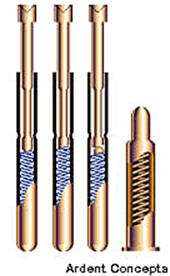 The Pogo Pin is an example of a compressive contact that has been successfully used in semiconductor and board-level test systems for many years. This spring-loaded contact has been adapted to address high-density applications in automated test equipment “bed of nails” and exhibits surprisingly good high-speed characteristics. Semiconductor sockets using spring pins have been rated to 28Gb/s, and are now available from suppliers such as Mill-Max in a wide range of mating heights, plating, and mating point configurations, including right-angle versions.
The Pogo Pin is an example of a compressive contact that has been successfully used in semiconductor and board-level test systems for many years. This spring-loaded contact has been adapted to address high-density applications in automated test equipment “bed of nails” and exhibits surprisingly good high-speed characteristics. Semiconductor sockets using spring pins have been rated to 28Gb/s, and are now available from suppliers such as Mill-Max in a wide range of mating heights, plating, and mating point configurations, including right-angle versions.
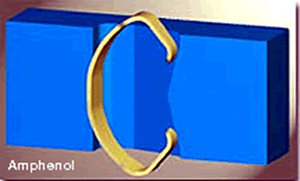
Land-grid array sockets have proven to be an effective interconnect for large processors that may have as many as 2,000 contact pads.
Connectors such as the solderless cLGA contact from Amphenol InterCon Systems is a simple compressible gold-over-nickel-plated beryllium copper C-shaped spring retained in a dielectric wafer.
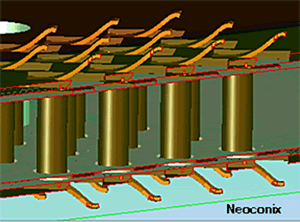
Manufacturers such as Neoconix have developed a line of interposer wafers with formed leaf contacts on one or both sides. These wafers can be as thin as 0.25mm with a contact grid of 0.8mm. Its PC Beam technology has been used in LGA, board-to-board, and flex-to-board applications.
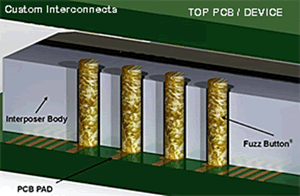 The Fuzz Button takes an entirely different approach to a compressible contact. It consists of a fine strand of gold-plated beryllium copper wire that has been compressed into a cylindrical shape. Buttons are loaded into a grid of holes in a plastic interposer or PCB that is slightly thinner than the buttons. When sandwiched between two conductive surfaces, the buttons compress to create very low-resistance connections. With a compressed height as low as 0.014”, the Fuzz Button performs at RF frequencies to 40GHz. Introduced in 1959, Fuzz Buttons are now manufactured by Custom Interconnects and continue to find applications in equipment designed for high performance in challenging environments, including those featuring extreme shock and vibration.
The Fuzz Button takes an entirely different approach to a compressible contact. It consists of a fine strand of gold-plated beryllium copper wire that has been compressed into a cylindrical shape. Buttons are loaded into a grid of holes in a plastic interposer or PCB that is slightly thinner than the buttons. When sandwiched between two conductive surfaces, the buttons compress to create very low-resistance connections. With a compressed height as low as 0.014”, the Fuzz Button performs at RF frequencies to 40GHz. Introduced in 1959, Fuzz Buttons are now manufactured by Custom Interconnects and continue to find applications in equipment designed for high performance in challenging environments, including those featuring extreme shock and vibration.
Cinch manufactures a similar product. The CIN::APSE contact is fabricated using gold-plated molybdenum wire. The exceptionally short connection can perform at up to 20GHz.
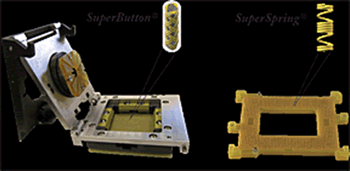 High Connection Density Inc. manufactures a button-like contact using a unique braided spring design. The SuperButton consists of wires that have been braided around an elastomeric core. The exposed contact ends are gold-plated to achieve low contact resistance. SuperSprings are elastic coil springs that feature an extended dynamic contact range. These contacts are assembled into interposer wafers and LGA socket assemblies. The SuperButton and SuperSpring contacts offer profiles as low as 0.8mm and high-frequency performance to 30GHz.
High Connection Density Inc. manufactures a button-like contact using a unique braided spring design. The SuperButton consists of wires that have been braided around an elastomeric core. The exposed contact ends are gold-plated to achieve low contact resistance. SuperSprings are elastic coil springs that feature an extended dynamic contact range. These contacts are assembled into interposer wafers and LGA socket assemblies. The SuperButton and SuperSpring contacts offer profiles as low as 0.8mm and high-frequency performance to 30GHz.

Ardent Concepts has developed two highly unique compressive contact styles. The RC Spring Probe utilizes a coiled spring to provide up to 60 grams of normal force per contact with up to 100,000 mating cycles. Contact pitch can be as low as 0.3mm.
The RC Connect-R is a cost-effective stamped solution that features a unique self-shorting contact when compressed to keep resistance and self-inductance to a minimum.
Over the years, a number of anisotropically conductive connector systems based on metallic conductors embedded in an elastomeric wafer have entered the market. Shin Etsu makes several series of connectors that consist of a tight grid of vertically oriented gold-plated brass wires embedded in a silicon rubber sheet. When compressed between stacked contact pads, the wires deflect, which results in a stored energy low-resistance connection. The small centerlines of the individual wires minimize the need to orient the conductive sheet to the location of the pads.
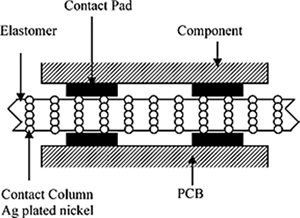
The Pariposer connector from Paricon Technologies is a unique variation of embedded conductors in an elastomeric carrier. The Pariposer is an anisotropically conductive polymer material that consists of vertically oriented columns of nickel-plated balls, which form conductive columns when compressed. The contact pitch can be as low as 0.10mm with compressed contact resistance as low as 6-10 milliohms.
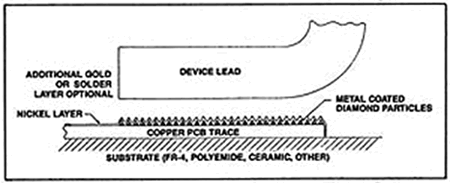 Metallized particle interconnects are an entirely different class of compressive contacts and have taken several forms over the years. PITek.US utilizes particle interconnect technology to achieve exceptionally low-profile and -resistance connections.
Metallized particle interconnects are an entirely different class of compressive contacts and have taken several forms over the years. PITek.US utilizes particle interconnect technology to achieve exceptionally low-profile and -resistance connections.
PITek interfaces consist of a matrix of sharp metallized diamond particles that are electrodeposited or stencil-deposited on the surface of conductive pads. When pressure as low as two grams is applied, the particles are compressed and penetrate any oxides or contamination on the mating surfaces. These redundant points of contact result in very low contact resistance across the joint. Metallized particle interconnects requires no wiping action to create a gas-tight connection, and can achieve exceptionally low mating profiles, as low as 0.001”.
The development of these contact systems demonstrates the degree of innovation that can be deployed to solve unconventional interconnect challenges. When an application cannot be satisfied with traditional contacts, designers are forced to prove once again that innovation is alive and well, at both large and small connector manufacturers.
- Optics Outpace Copper at OFC 2024 - April 16, 2024
- Digital Lighting Enhances your Theatrical Experience - March 5, 2024
- DesignCon 2024 in Review - February 13, 2024



